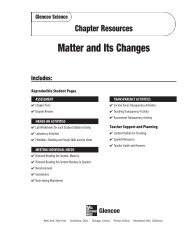Chapter 17: Invertebrate Animals
Chapter 17: Invertebrate Animals
Chapter 17: Invertebrate Animals
Create successful ePaper yourself
Turn your PDF publications into a flip-book with our unique Google optimized e-Paper software.
Arthropods and<br />
Echinoderms<br />
SuperStock<br />
■ List the features used to classify<br />
arthropods.<br />
■ Explain how the structure of the<br />
exoskeleton relates to its function.<br />
■ Identify features of echinoderms.<br />
Arthropods and echinoderms show<br />
great diversity and are found in<br />
many different environments.<br />
Review Vocabulary<br />
regeneration: regrowth of a<br />
body or body part after injury or<br />
as a normal process<br />
New Vocabulary<br />
• arthropod<br />
appendage<br />
• exoskeleton<br />
metamorphosis<br />
Figure <strong>17</strong> About 8,000 species<br />
of ants are found in the world.<br />
Ants are social insects that live<br />
cooperatively in colonies.<br />
Arthropods<br />
More than a million species of arthropods (AR thruh pahdz)<br />
have been discovered. They are the largest and most diverse<br />
group of animals. The term arthropod comes from arthros,<br />
meaning “jointed,” and poda, meaning “foot.” Arthropods are<br />
animals that have jointed appendages (uh PEN dih juz).<br />
Appendages are structures such as claws, legs, and antennae that<br />
grow from the body.<br />
Arthropods have a rigid body covering called an exoskeleton. It<br />
protects and supports the body and reduces water loss. The weight<br />
of the outer covering increases as the size of the animal increases.<br />
As the animal grows, the exoskeleton must be shed because it<br />
doesn’t grow with the animal. This process is called molting. Weight<br />
and hardness of the exoskeleton could make it difficult to move, but<br />
the jointed appendages solve part of this problem.<br />
What is the function of the exoskeleton<br />
Arthropods have bilateral symmetry and segmented bodies<br />
similar to annelids. In most cases, arthropods have fewer, more<br />
specialized segments. Instead of setae, they have appendages.<br />
Insects If asked to name an insect, you might say bee,<br />
fly, beetle, or butterfly. Insects make up the largest group of<br />
arthropods. More than 700,000 species of insects have been<br />
classified, and scientists discover and describe more of them<br />
each year.<br />
Insects, like the ant in Figure <strong>17</strong>, have three<br />
body regions—head, thorax, and abdomen. Welldeveloped<br />
sensory organs, including the eyes and<br />
antennae, are located on the head. The thorax has<br />
three pairs of jointed legs and usually one or two<br />
pairs of wings. The wings and legs of insects are<br />
highly specialized. The abdomen is divided into<br />
segments and has neither wings nor legs attached,<br />
but reproductive organs are located there.<br />
Abdomen Thorax Head














